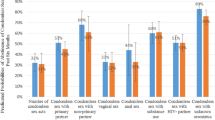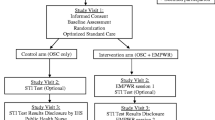Abstract
African Americans who use substances experience a particular risk for HIV. Negative attitudes towards condoms are a strong predictor of risk and can serve as barriers to safe sex. They also vary by gender. In a secondary analysis of data from two National Drug Abuse Treatment Clinical Trials Network trials collecting data from 2004 to 2006, the relationship between gender, unprotected sex, and condom barriers among 203 African Americans in substance use treatment was examined. Results indicated that no gender differences were present in unprotected sex. Men reported more motivational barriers to condom use and were more likely to believe that condoms would impede sexual experience (the latter not statistically significant). For both genders, the perception that condoms might negatively impact sexual experience was associated with unprotected sex. Gender did not moderate the relationship between condom barriers and unprotected sex. These findings suggest the need for gender and race-specific prevention strategies that focus on motivation and address pleasure-based concerns regarding condoms. Substance use treatment facilities are well-positioned to support interventions to target these issues.
Similar content being viewed by others
References
Abraham, A. J., Andrews, C. M., Grogan, C. M., D’Aunno, T., Humphreys, K. N., Pollack, H. A., & Friedmann, P. D. (2017). The affordable care act transformation of substance use disorder treatment. American Journal of Public Health, 107(1), 31–32.
Adimora, A. A., Schoenbach, V. J., & Floris-Moore, M. A. (2009). Ending the epidemic of heterosexual HIV transmission among African Americans. American Journal of Preventive Medicine, 37, 468–471.
Burlew, A. K., Copeland, V. C., Ahuama-Jonas, C., & Calsyn, D. A. (2013). Does cultural adaptation have a role in substance abuse treatment? Social Work in Public Health, 28(3–4), 440–460.
Calsyn, D. A., Campbell, A. N., Tross, S., & Hatch-Maillette, M. A. (2011). Is monogamy or committed relationship status a marker for low sexual risk among men in substance abuse treatment? Clinical and methodological considerations. The American Journal of Drug and Alcohol Abuse, 37(5), 294–300.
Calsyn, D. A., Hatch-Maillette, M., Tross, S., Doyle, S. R., Crits-Christoph, P., Song, Y. S., Harrer, J. M., Lalos, G., & Berns, S. B. (2009). Motivational and skills training HIV/sexually transmitted infection sexual risk reduction groups for men. Journal of Substance Abuse Treatment, 37(2), 138–150.
Calsyn, D. A., Peavy, M., Wells, E. A., Campbell, A. N., Hatch-Maillette, M. A., Greenfield, S. F., & Tross, S. (2013). Differences between men and women in condom use, attitudes, and skills in substance abuse treatment seekers. The American Journal on Addictions, 22(2), 150–157.
Calsyn, D. A., Wells, E. A., Saxon, A. J., Jackson, R., & Heiman, J. R. (2001). Sexual activity under the influence of drugs is common among methadone clients. In Problems of Drug Dependence 1999. Harris LS, ed. NIH Pub. No. 00-4773. Rockville, MD: National Institute on Drug Abuse, 2000; 315.
Centers for Disease Control and Prevention (CDC). (2018a). Estimated HIV incidence and prevalence in the United States, 2010–2015. HIV Surveillance Supplemental Report 2018. Retrieved from http://www.cdc.gov/hiv/library/reports/hiv-surveillance.html.
Centers for Disease Control and Prevention (CDC). (2018b). HIV and substance use in the United States. Retrieved from https://www.cdc.gov/hiv/risk/substanceuse.html.
Centers for Disease Control and Prevention (CDC). (2020). HIV Testing. Retrieved from https://www.cdc.gov/hiv/testing/index.html.
Charnigo, R., Crosby, R. A., & Troutman, A. (2010). Psychosocial constructs associated with condom use among high-risk African American men newly diagnosed with a sexually transmitted disease. Annals of Behavioral Medicine, 39, 303–310.
Copen, C. E. (2017). Condom use during sexual intercourse among women and men aged 15–44 in the United States: 2011–2015 National Survey of Family Growth. National Health Statistics Reports, 105, 1–18.
Crosby, R., Shrier, L. A., Charnigo, R., Sanders, S. A., Graham, C. A., Milhausen, R., et al. (2013). Negative perceptions about condom use in a clinic population: Comparisons by gender, race and age. International Journal of STD and AIDS, 24, 100–105.
Doyle, S. R., Calsyn, D. A., & Ball, S. A. (2009). Factor structure of the condoms barriers scale with a sample of men at high risk for HIV. Assessment, 16, 3–15.
Hayes, A. F. (2012). PROCESS: A versatile computational tool for observed variable mediation, moderation, and conditional process modeling [White paper]. Retrieved from http://www.afhayes.com/public/process2012.pdf.
Laurecin, C. T., Christensen, D. M., & Taylor, E. D. (2008). HIV/AIDS and the African-American community: a state of emergency. Journal of the National Medical Association, 100, 35–43.
Lawrence, J. S. S., Chapdelaine, A. P., Devieux, J. G., O’Bannon, R. E., Brasfield, T. L., & Eldridge, G. D. (1999). Measuring perceived barriers to condom use: Psychometric evaluation of the Condom Barriers Scale. Assessment, 6, 391–404.
Lefkowitz, E. S., Shearer, C. L., Gillen, M. M., & Espinosa-Hernandez, G. (2014). How gendered attitudes relate to women’s and men’s sexual behaviors and beliefs. Sexuality and Culture, 18(4), 833–846.
Macaluso, M., Demand, M. J., Artz, L. M., & Hook, E. W. I. I. I. (2000). Partner type and condom use. AIDS, 14(5), 537–546.
McLellan, A., Cacciola, J., Kushner, H., Peters, F., Smilth, L., & Pettinati, H. (1992). The fifth edition of the Addiction Severity Index. Journal of Substance Abuse Treatment, 9, 199–213.
Meyer-Bahlburg, H., Ehrhardt, A., Exner, T. M., & Gruen, R. S. (1991). Sexual risk behavior assessment schedule—adult armory interview (SERBAS A-ARM). New York, NY: New York State Psychiatric Institute and Columbia University.
Miller, W. R., & Rollnick, S. (2013). Motivational interviewing: Helping people change (3rd ed.). New York, NY: Guilford Press.
Miranda, J., Bernal, G., Lau, A., Kohn, L., Hwang, W. C., & LaFromboise, T. (2005). State of the science on psychosocial interventions for ethnic minorities. Annual Review of Clinical Psychology, 1, 113–142.
Noar, S. M., Webb, E., Van Stee, S., Feist-Price, S., Crosby, R., Willoughby, J. F., & Troutman, A. (2012). Sexual partnerships, risk behaviors, and condom use among low-income heterosexual African Americans: a qualitative study. Archives of Sexual Behavior, 41, 959–970.
Prendergast, M. L., Urada, D., & Podus, D. (2001). Meta-analysis of HIV risk-reduction interventions within drug abuse treatment programs. Journal of Consulting and Clinical Psychology, 69, 389–405.
Randolph, M. E., Pinkerton, S. D., Bogart, L. M., Cecil, H., & Abramson, P. R. (2007). Sexual pleasure and condom use. Archives of Sexual Behavior, 36(6), 844–848.
Reece, M., Herbenick, D., Schick, V., Sanders, S. A., Dodge, B., & Fortenberry, J. D. (2010). Condom use rates in a national probability sample of males and females ages 14–94 in the United States. The Journal of Sexual Medicine, 7, 266–276.
Soet, J. E., Dudley, W. N., & Dilorio, C. (1999). The effects of ethnicity and perceived power on women’s sexual behavior. Psychology of Women Quarterly, 23(4), 707–723.
Strada, M. J., Donohue, B., & Lefforge, N. L. (2006). Examination of ethnicity in controlled treatment outcome studies involving adolescent substance abusers: a comprehensive literature review. Psychology of Addictive Behaviors, 20(1), 11–27.
Tabachnick, B. G., & Fidell, L. S. (2001). Using multivariate analysis. California State University Northridge: Harper Collins College Publishers.
Tross, S., Campbell, A. N., Cohen, L. R., Calsyn, D., Pavlicova, M., Miele, G. M & Nunes, E. V. (2008). Effectiveness of HIV/STD sexual risk reduction groups for women in substance abuse treatment programs: Results of NIDA Clinical Trials Network Trial. Journal of Acquired Immune Deficiency Syndrome, 45, 581–589.
United Nations Programme on HIV/AIDS (UNAIDS). (2018). Fast-Track: Ending the AIDS epidemic by 2030. Retrieved from http://www.unaids.org/sites/default/files/media_asset/JC2686_WAD2014report_en.pdf.
U.S. Food and Drug Administration (FDA). (2019). FDA in Brief: FDA continues to encourage ongoing education about the benefits and risks associated with PrEP, including additional steps to help reduce the risk of getting HIV. Retrieved from https://www.fda.gov/news-events/fda-brief/fda-brief-fda-continues-encourage-ongoing-education-about-benefits-and-risks-associated-prep.
Wendt, S. J., & Solomon, L. J. (1995). Barriers to condom use among heterosexual male and female college students. Journal of American College Health, 44(3), 105–110.
Wilson, J., Burlew, A. K., Montgomery, L., Peteet, B., Johnson, C., & Hatch-Maillette, M. (2014). Do masculinity and perceived condom barriers predict heterosexual HIV risk behaviors among black substance abusing men? Journal of Health Disparities Research and Practice, 5, 1–23.
Wingood, G. M., & DiClemente, R. J. (2000). Application of the Theory of Gender and Power to examine HIV-related exposures, risk factors, and effective interventions for women. Health Education & Behavior, 27, 539–565.
Funding
This study has no funding to report.
Author information
Authors and Affiliations
Corresponding author
Ethics declarations
Conflict of interest
No authors have any conflicts of interest to report.
Ethical Standards
The study was deemed by institutional IRB as non-human subjects research because it was a secondary data analysis and all identifiers were removed.
Additional information
Publisher's Note
Springer Nature remains neutral with regard to jurisdictional claims in published maps and institutional affiliations.
Rights and permissions
About this article
Cite this article
McCuistian, C., Peteet, B.J., Burlew, A.K. et al. Sexual Risk Among African Americans in Substance Use Treatment: Secondary Analysis of Two Clinical Trials. Sexuality & Culture 24, 2065–2078 (2020). https://doi.org/10.1007/s12119-020-09737-1
Published:
Issue Date:
DOI: https://doi.org/10.1007/s12119-020-09737-1




